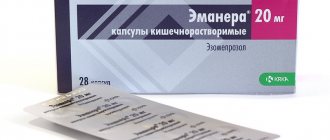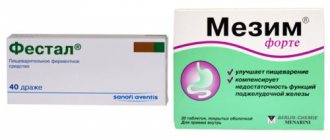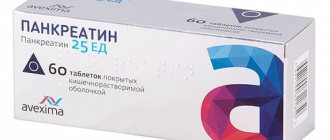Compound
One enteric capsule of the drug Pangrol 10000 contains mini-tablets coated with a special coating, the core of which contains 153.5 mg. such an active component as pancreatin.
In addition, the medicine contains such auxiliary elements as: magnesium stearate (0.84 mg), croscarmellose sodium (5.1 mg), hydrogenated castor oil (1.7 mg), colloidal anhydrous silicon dioxide (0. 84 mg.), as well as microcellulose (8.5 mg.).
The shell of enteric mini-tablets contained in Pangrol 10000 capsules consists of a mixture of compounds such as: talc (5 mg), 30% dispersion of a copolymer of ethyl acrylate and methacrylic acid in a 1:1 ratio (25 mg), triethyl citrate (2.5 mg.), 30% emulsion of simethicone in the form of dry mass (0.01 mg.).
The body and cap of the capsule contain the following chemical compounds: gelatin, titanium dioxide and dyes such as indigo carmine, yellow and red iron oxide, as well as E104 (quinoline yellow).
The chemical composition of one enteric capsule Pangrol 25000 contains mini-tablets with 356.1 mg. pancreatin. The core of the drug contains such auxiliary components as: microcellulose (19.7 mg), croscarmellose sodium (11.8 mg), silicon dioxide (1.97 mg), magnesium stearate (1.97 mg) and hydrogenated castor oil (3.96 mg.).
The shell of the mini-tablets is a mixture of the following components: talc (11.6 mg), 30% copolymer dispersion (1:1 ratio) of methacrylic acid and ethyl acrylate (57.9 mg), triethyl citrate (5.8 mg) , 30% dry emulsion of simethicone (0.03 mg.).
The cap and body of the enteric capsule Pangrol 25000 contain the following components: titanium dioxide, gelatin and dyes (indigo carmine, yellow and red iron oxide, as well as quinoline yellow).
One Pangrol 20000 tablet contains pancreatin , as well as lactulose monohydrate, microcrystalline cellulose (MCC), crospovidone, silicon dioxide, magnesium stearate, methacrylic acid-ethyl acrylate copolymer, methylhydroxypropylcellulose, simethicone emulsion, talc, macrogol 6000, polysorbate 80 and sodium carboxymethylcellulose.
The composition of the three dosage forms of the drug capsules Pangrol 10000, Pangrol 25000, and tablets Pangrol 20000 differs in the minimum activity of such components of the active compound as: proteases (500 IU, 1250 IU and 900 IU), lipase (10000 IU, 25000 IU and 20000 IU ), as well as amylase (9000 units, 22500 units and 12 units).
Release form
Pangrol 10000 and 25000 are produced in the form of capsules (opaque, gelatinous, hard) No. 2 and No. 0, respectively, which have a cylindrical shape. The capsule body is distinguished by its light orange color, and the capsule cap by its yellow-green hue. The contents of the drug capsules are mini-tablets, which also have a cylindrical shape, are distinguished by a light beige color of the enteric coating and a shiny surface.
As a rule, the cardboard packaging of Pangrol 10000 and 25000 contains a polypropylene bottle, which can contain 20, 50 or 100 capsules. Pangrol 20000 are wallpaper-convex enteric tablets, coated with a medicinal film, having a smooth surface and a gray-white color. The tablets are packaged in blisters and placed in cardboard packages of 20 or 50 pieces.
Pharmacodynamics and pharmacokinetics
Pancreatin or the active medicinal substance contained in Pangrol is a powder that is obtained by processing pork pancreas. The enzymes contained in the powder have a positive effect on the digestion and accelerate the breakdown of fats, carbohydrates and proteins, and, in addition, help normalize the functioning of the pancreas .
Due to the fact that the drug promotes complete digestion of food, the medicine relieves symptoms of such digestive disorders as shortness of breath resulting from the accumulation of gases and fullness of the stomach, a feeling of heaviness and pain in the abdomen, as well as flatulence . The drug stimulates the pancreas, small intestine and stomach of a person to produce enzymes involved in the digestive process.
The bile extract included in Pangrol enhances the emulsification of fats and has a choleretic , i.e. lipase activity , thereby improving the digestion and absorption by the stomach of important fat-soluble vitamins of the group, and K , as well as fats that enter the body with food.
Pangrol capsules and tablets are coated with a specialized acid-resistant coating, which helps protect the drug from gastric juice until the drug enters the small intestine . The capsule shell quickly dissolves and releases mini-tablets containing enzymes, which in turn mix with the intestinal contents, thus ensuring the required level of enzymes and their even distribution.
For the drug to have an effective medicinal effect, it is important to maintain a neutral or slightly alkaline pH level the small intestine . Pangrol is not absorbed by the gastrointestinal tract and is excreted from the body in feces.
Pharmacological properties of the drug Pangrol
Pharmacodynamics . Pancreatin is a pancreatic enzyme that takes part in the digestion of proteins, fats and carbohydrates. The digestive activity of the drug is determined by the activity of the enzymes included in its composition. The determining factor is the enzymatic activity of lipase, as well as the trypsin content, while amylolytic activity is important only in the treatment of cystic fibrosis, since, even with a significant decrease in the secretory activity of the pancreas, amylase has sufficient activity. Pancreatin is a powder made from the pancreas of pigs, containing the main pancreatic digestive enzymes (lipase, amylase, trypsin, chymotrypsin), as well as other substances that do not have enzymatic activity. Pancreatic lipase cleaves fatty acids from the triacylglyceride molecule at positions 1 and 3. The resulting free fatty acids and 2-monoglycerides with the participation of bile acids are quickly absorbed in the upper part of the small intestine. Pancreatic lipase of animal origin, like human lipase, is not acid-resistant, therefore, at a pH value of ≤4, the inactivation of its lipolytic activity irreversibly increases. Activation of trypsin from trypsinogen occurs autocatalytically or under the influence of enterokinase of the small intestine, and trypsin, for its part, causes the activation of other proteolytic enzymes, cleaves peptide bonds in which lysine and arginine are involved, and thus, together with other enzymes, promotes the breakdown of proteins into amino acids and small peptides. It is assumed that stimulated pancreatic secretion is inhibited by a feedback mechanism under the influence of active trypsin in the upper part of the small intestine, which is associated with some analgesic effect of pancreatin preparations. The amylase enzyme quickly breaks down glucose-containing polysaccharides. The acid-resistant coating of the tablet/capsule protects enzymes sensitive to gastric juice when passing through the stomach from inactivation by hydrochloric acid. The dissolution of the membrane and the release of enzymes occurs in the small intestine in an environment optimal for the manifestation of their activity. Enzymes are not absorbed in the digestive tract; they act in the intestinal lumen. Pharmacokinetics. Due to the fact that pancreatin is not absorbed and not detected in blood plasma, it is not possible to provide data on its pharmacokinetics and bioavailability.
Indications for use
Pangrol is used in the replacement therapeutic treatment of both adults and children with impaired exocrine function of the pancreas , as well as with relative enzyme deficiency caused by diseases such as:
- pancreatic cancer or narrowing of the duct associated with the presence of gallstones or a malignant tumor ;
- pancreatitis , including pre-acute or chronic stages of the disease;
- Shwachman-Diamond syndrome;
- intestinal infections;
- irritable bowel syndrome;
- disorders of the gastrointestinal tract of a functional nature;
- cystic fibrosis.
In addition, the drug is used to prepare for ultrasound or x-ray examination of the abdominal cavity , as well as to restore normal functioning of the pancreas and stomach after surgery, for example, after resection or as part of complex therapeutic treatment after radiation in the presence of symptoms such as diarrhea, not digestion of food and flatulence .
Indications for use of the drug Pangrol
Exocrine pancreatic insufficiency in chronic pancreatitis, cystic fibrosis; dyspeptic phenomena caused by simultaneous resection of the stomach and small intestine, functional disorders of intestinal motility (accelerated passage of chyme through the intestines), dyskinesia of the bile ducts, consumption of indigestible plant, fatty or unusual foods; flatulence; preparation for radiographic and sonographic examinations of the abdominal organs.
Side effects
While taking the drug, side effects may occur such as nausea, bloating and vomiting , as well as diarrhea, abdominal pain and other digestive system disorders . Quite rarely, patients experience an allergic reaction to Pangrol, which is usually expressed in the appearance of itching, hives or rash on the skin . If you notice the above-described ailments, you should stop using the medicine and consult a doctor.
Side effects of the drug Pangrol
In some cases, immediate allergic reactions (skin rash, sneezing, lacrimation, bronchospasm). In cystic fibrosis, taking the drug in high doses can lead to the formation of strictures in the ileocecal region and the ascending colon. Constipation and intestinal obstruction are known complications in patients with cystic fibrosis. Therefore, if there are complaints characteristic of intestinal obstruction, the possibility of strictures along the intestinal tract should be taken into account. Also, with long-term use of the drug in high doses, hyperuricosuria may develop in cystic fibrosis, therefore, to prevent the formation of urate stones, it is necessary to control the level of uric acid in the urine.
Instructions for use of Pangrol 10000 (Method and dosage)
Pangrol capsules and tablets are taken with food, without chewing and swallowed whole, with liquid, preferably plain water at room temperature. The dosage of the drug is determined by the doctor and depends on the patient’s condition, severity and form of the disease. The following average therapeutic doses are provided for the drug in capsules:
- adults - 2-4 or 1-2 capsules of Pangrol 10,000 and 25,000, respectively;
- for children - at the rate of 500-1000 units of lipase per kilogram with each meal.
In accordance with the instructions for Pangrol 20000 tablets, take 1-2 pieces. during the actual meal. The average therapeutic dosage of the drug may vary depending on the disease, and also depends on the food that is included in the patient’s diet. The doctor can increase the daily dose of a drug containing digestive enzymes in its chemical composition, within the maximum permissible 15,000-20,000 units of lipase per kilogram.
The duration of treatment depends on the severity and type of disease, as well as the patient’s health condition. If the patient cannot take a whole Pangrol capsule on his own (elderly people or children), you can pour its contents (mini-tablets) into a liquid, such as water, or mix it with food that does not require chewing (fruit puree). The mixture of food and mini-tablets should be taken immediately and should not be stored.
When treating cystic fibrosis, the dosage of the drug depends on the patient's body weight.
The initial dosage of Pangrol for children under 4 years of age is 1000 units of lipase per kilogram, and for children over 4 years of age - 500 units. When using the medicine in pediatric therapeutic treatment, you must follow a diet to avoid the development of steatorrhea .
Pangrol 10000 capsules intestinal products No. 50
Compound
Capsule contents (enteric-coated mini-tablets):
Core:
Active substance: pancreatin -153.5 mg with minimal activity:
- lipase 10000 units
- amylase 9000 units
- protease 500 units
Excipients: croscarmellose sodium - 5.12 mg, microcrystalline cellulose - 8.52 mg, hydrogenated castor oil - 1.709 mg, colloidal anhydrous silicon dioxide - 0.849 mg, magnesium stearate - 0.849 mg.
Shell: methacrylic acid and ethyl acrylate copolymer (1:1), 30% dispersion - 25.0 mg, triethyl citrate - 2.51 mg, simethicone emulsion 30% (dry weight) - 0.015 mg; talc - 5.01 mg;
Capsule: body: gelatin - 36.20 mg, titanium dioxide (E 171) - 0.20 mg; iron dye yellow oxide (E 172) - 0.20 mg; red iron oxide dye (E 172) - 0.01 mg; cap: gelatin - 23,800 mg; titanium dioxide (E 171) - 0.400 mg; quinoline yellow dye (E 104) - 0.200 mg; indigo carmine (E 132) - 0.002 mg.
Pharmacokinetics
Gelatin capsules of the drug Pangrol® 10000 quickly dissolve in the stomach, releasing mini-tablets coated with an enteric (acid-resistant) coating. Thus, the enzymes remain protected from inactivation in the acidic environment of the stomach. The release form of the drug ensures mixing of mini-tablets with intestinal contents and uniform distribution of enzymes. Dissolution of the mini-tablet shell and activation of enzymes occurs at a neutral or slightly alkaline pH in the small intestine. Pancreatin is not absorbed from the gastrointestinal tract and is excreted in the feces.
Indications for use
Replacement therapy for exocrine pancreatic insufficiency in adults and children in the following conditions:
- chronic pancreatitis;
- cystic fibrosis;
- pancreas cancer;
- conditions after surgical interventions on the pancreas and stomach (complete or partial resection of the organ);
- after irradiation of the gastrointestinal tract, accompanied by impaired digestion of food, flatulence, diarrhea (as part of combination therapy);
- narrowing of the pancreatic duct, for example due to a tumor or gallstones;
- Shwachman-Diamond syndrome;
- subacute pancreatitis;
- other diseases accompanied by exocrine pancreatic insufficiency.
Relative enzyme deficiency in the following conditions and situations:
- gastrointestinal disorders of a functional nature, with acute intestinal infections, irritable bowel syndrome;
- consumption of indigestible plant or fatty foods.
Preparation for x-ray and ultrasound examinations of the abdominal organs.
Contraindications
- Acute pancreatitis;
- exacerbation of chronic pancreatitis;
- hypersensitivity to porcine pancreatin or other components of the drug.
Directions for use and doses
The dose of Pangrol® 10000 is selected individually depending on the severity of the disease, as well as the volume and composition of food taken.
Unless otherwise indicated, adults are recommended to take 2-4 capsules of Pangrol® 10000 with each meal, swallowing the capsules whole (do not chew) with a sufficient amount of liquid (for example, a glass of water). If it is difficult for the patient to take a whole capsule (for example, in small children or elderly patients), you can pour its contents, for example, into a glass, opening the capsule by separating the cap from the body, and then take the contents (mini-tablets) with a small amount liquids or added to liquid foods that do not require chewing (such as applesauce or fruit juice). The mixture of mini-tablets with food or liquid cannot be stored (take immediately after preparation).
Increasing the dose of the drug should be carried out only under the supervision of a physician, focusing on the dynamics of symptoms (for example, a decrease in steatorrhea, easing abdominal pain).
It is not recommended to exceed the daily dose of enzymes, which is 15,000-20,000 lipase units/kg of body weight.
The duration of treatment is determined by the doctor and depends on the course of the disease.
For children, the dosage regimen and duration of treatment are determined by the doctor depending on the severity of the disease and the composition of the food at the rate of 500 - 1000 lipase units / kg of the child’s body weight for each meal.
Use for cystic fibrosis
The dose of Pangrol® 10000 depends on body weight and at the beginning of treatment should be 1000 lipase units/kg at each meal for children under 4 years of age, and 500 lipase units/kg at each meal for children over 4 years of age.
The dose of the drug should be selected individually depending on the severity of the disease, under the control of steatorrhea and the support of an optimal diet. For most patients, the dose should be no more than 10,000 lipase units/kg body weight per day or 4,000 lipase units/g fat consumed.
Storage conditions
Store at a temperature not exceeding 25°C. Keep the medicine out of the reach of children.
Best before date
2 years. Do not use after the expiration date stated on the package.
special instructions
In patients suffering from cystic fibrosis who received high doses of pancreatin preparations, strictures of the ileum, cecum and colon (fibrosing colonopathy) have been described. As a precautionary measure, if unusual symptoms appear or changes in the nature of the symptoms of the underlying disease, a medical examination is necessary to exclude damage to the colon, especially if the drug is used at a dose of more than 10,000 lipase units per kg of body weight per day.
Description
Digestive enzyme agent.
Pharmacodynamics
The active ingredient of Pangrol® 10000 is pancreatin, which is a powder from the pancreas of pigs. The enzymes that make up pancreatin help break down fats, carbohydrates and proteins coming from food. Pancreatin, having proteolytic, amylolytic and lipolytic effects, compensates for enzymatic insufficiency of the pancreas, improves the functional state of the gastrointestinal tract (GIT), and normalizes digestive processes.
Side effects
Possible side effects are listed below in descending frequency of occurrence: often (≥ 1/100, < 1/10), uncommon (≥ 1/1000, < 1/100), rare (≥ 1/10000, < 1/1000), very rare (<1/10000), including isolated reports.
Gastrointestinal disorders:
Common: nausea, vomiting and bloating.
Gastrointestinal disorders are mainly associated with the underlying disease. The incidence of the following adverse reactions was lower or similar to that observed with placebo:
Very common: pain in the abdomen; often: diarrhea.
Disorders of the skin and subcutaneous tissues:
Rarely: rash;
Itching, urticaria - there is insufficient data to estimate the frequency of cases.
Use during pregnancy and breastfeeding
Pregnancy
There are no clinical data on the treatment of pregnant women with drugs containing pancreatic enzymes. Animal studies have not revealed the absorption of pancreatic enzymes of porcine origin, therefore toxic effects on reproductive function and fetal development are not expected.
The use of Pangrol® 10000 during pregnancy is possible if the expected benefit to the mother outweighs the possible risk to the fetus.
Breastfeeding period
Based on animal studies in which no negative effects of pancreatic enzymes were detected, no harmful effects of the drug on the child through breast milk are expected. You can take pancreatic enzymes while breastfeeding.
Interaction
No interaction studies have been conducted.
Overdose
Symptoms: The use of large doses of pancreatic enzymes may be accompanied by hyperuricosuria and hyperuricemia in patients with cystic fibrosis.
Treatment: drug withdrawal, symptomatic therapy.
Impact on the ability to drive vehicles and operate machinery
Pangrol® 10000 does not affect the performance of potentially hazardous activities that require special attention and speed of reaction.
special instructions
When treating cystic fibrosis , patients receiving large doses of the drug may experience fibrosing colonopathy , i.e. strictures of the ileum, colon and cecum . In order to avoid changes in the symptoms of the underlying disease, before directly taking Pangrol, a medical study should be conducted to rule out the presence of lesions in the patient's colon .
The medicine does not affect the ability to drive vehicles and does not reduce reaction speed when working with potentially dangerous mechanisms.
Analogues of Pangrol 10000
Level 4 ATC code matches:
Digestin
Creon
Pancitrate
Mezim
Festal
Pankreoflat
Pancreazim
Enterosan
Panzinorm Forte
Panzinorm
Micrasim
Enzistal P
Pancreatin
Penzital
Hermital
Abomin
The following drugs can be considered the main structural analogues of the drug:
- Gastenorm Forte;
- Creon 10000, 25000 and 40000;
- Mezim;
- Micrasim;
- Mezim Forte;
- PanziCam;
- Panzinorm;
- Pancreatin;
- Panzinorm Forte;
- Panzim Forte;
- Pancreatin-LekT;
- Pancitrate;
- Festal;
- Pancreatin Forte;
- Penzital;
- Enzistal-P;
- Pancrelipase;
- Hermital.
During pregnancy and lactation
Although pregnancy and breastfeeding are not included in the list of absolute contraindications to the use of Pangrol, there are no reliable results of clinical studies aimed at identifying the effects of pancreatin on fetal development. Since testing of pancreatic enzymes was carried out on animals and was successful, experts exclude the possibility of a toxic effect of the drug on the development of the unborn child.
However, the use of Pangrol during pregnancy is possible only in the absence of contraindications, and is also justified only if the expected benefits of the drug outweigh the possible negative consequences. It is allowed to take this medicine while breastfeeding.
Pangrol (Mezim Neo) enteric capsules 25,000 units 50 pcs. in Moscow
Enzyme preparation Indications Replacement therapy for insufficiency of exocrine pancreatic function in adults and children under the following conditions: - chronic pancreatitis; - cystic fibrosis; - pancreas cancer; — conditions after surgical interventions on the pancreas and stomach (complete or partial resection of the organ); — after irradiation of the gastrointestinal tract, accompanied by impaired digestion of food, flatulence, diarrhea (as part of combination therapy); - narrowing of the pancreatic duct (for example, due to a tumor or gallstones); - Shwachman-Diamond syndrome; - subacute pancreatitis; - other diseases accompanied by exocrine pancreatic insufficiency.
Relative enzyme deficiency in the following conditions and situations: - functional gastrointestinal disorders, - acute intestinal infections; - with irritable bowel syndrome; - consumption of indigestible plant or fatty foods.
Preparation for x-ray and ultrasound examinations of the abdominal organs.
Contraindications: acute pancreatitis; - exacerbation of chronic pancreatitis; - hypersensitivity to porcine pancreatin or other components of the drug.
Use during pregnancy and breastfeeding There are no clinical data on the treatment of pregnant women with drugs containing pancreatic enzymes. Animal studies have not revealed the absorption of pancreatic enzymes of porcine origin, therefore toxic effects on reproductive function and fetal development are not expected.
The use of Pangrol® 25000 during pregnancy is possible if the expected benefit to the mother outweighs the possible risk to the fetus
Based on animal studies in which no negative effects of pancreatic enzymes were detected, no harmful effects of the drug on the child through breast milk are expected. You can take pancreatic enzymes while breastfeeding.
Special instructions In patients suffering from cystic fibrosis who received high doses of pancreatin preparations, strictures of the ileum, cecum and colon (fibrosing colonopathy) have been described. As a precautionary measure, if unusual symptoms appear or changes in the nature of the symptoms of the underlying disease, a medical examination is necessary to exclude damage to the colon, especially when using the drug at a dose of more than 10,000 lipase units/kg body weight per day.
Impact on the ability to drive vehicles and operate machinery
Pangrol® 25000 does not affect the performance of potentially hazardous activities that require special attention and speed of reaction.
Side effects Possible side effects are listed below in descending frequency of occurrence: common (> 1/100, < 1/10), uncommon (> 1/1000, < 1/100), rare (> 1/10000, < 1/1000) , very rare (< 1/10000), including isolated reports. From the gastrointestinal tract: often - nausea, vomiting and bloating. Gastrointestinal disorders are mainly associated with the underlying disease. The incidence of the following adverse reactions was lower or similar to those with placebo: very common - abdominal pain; often - diarrhea. From the skin and subcutaneous tissues: rarely - rash; There is not enough data to estimate the frequency of cases - itching, urticaria.
Drug interactions No interaction studies have been conducted
Pangrol price, where to buy
The cost of the drug depends on its dosage form. For example, a package of Pangrol 20000 (50 tablets) can be purchased for an average of 1000 rubles.
The price of Pangrol 10,000 (pack, 20 capsules) on average does not exceed 250 rubles.
The average price of Pangrol 25,000 (pack, 20 capsules) is 1,000 rubles.
- Online pharmacies in RussiaRussia
- Online pharmacies in UkraineUkraine
- Online pharmacies in KazakhstanKazakhstan
Pharmacy Dialogue
- Pangrol (caps. 10000 units No. 20) Aptalis farm
265 rub. order - Pangrol (caps. 25000 units No. 20)Aptalis farm
468 RUR order
show more
Pharmacy24
- Pangrol 25000 No. 20 capsules Berlin Chemi AG, Nimechchina
369 UAH.order - Pangrol 10000 No. 20 capsules Berlin Chemi AG, Nimechchina
193 UAH order
PaniPharmacy
- Pangrol 10000 capsule Pangrol 10000 caps.tv. with intestinal solution mini-tablet. No. 20 Germany, Berlin-Chemie
202 UAH. order
- Pangrol 25000 capsule Pangrol 25000 caps.tv. with intestinal solution mini-tablet. No. 20 Germany, Berlin-Chemie
401 UAH order
show more









